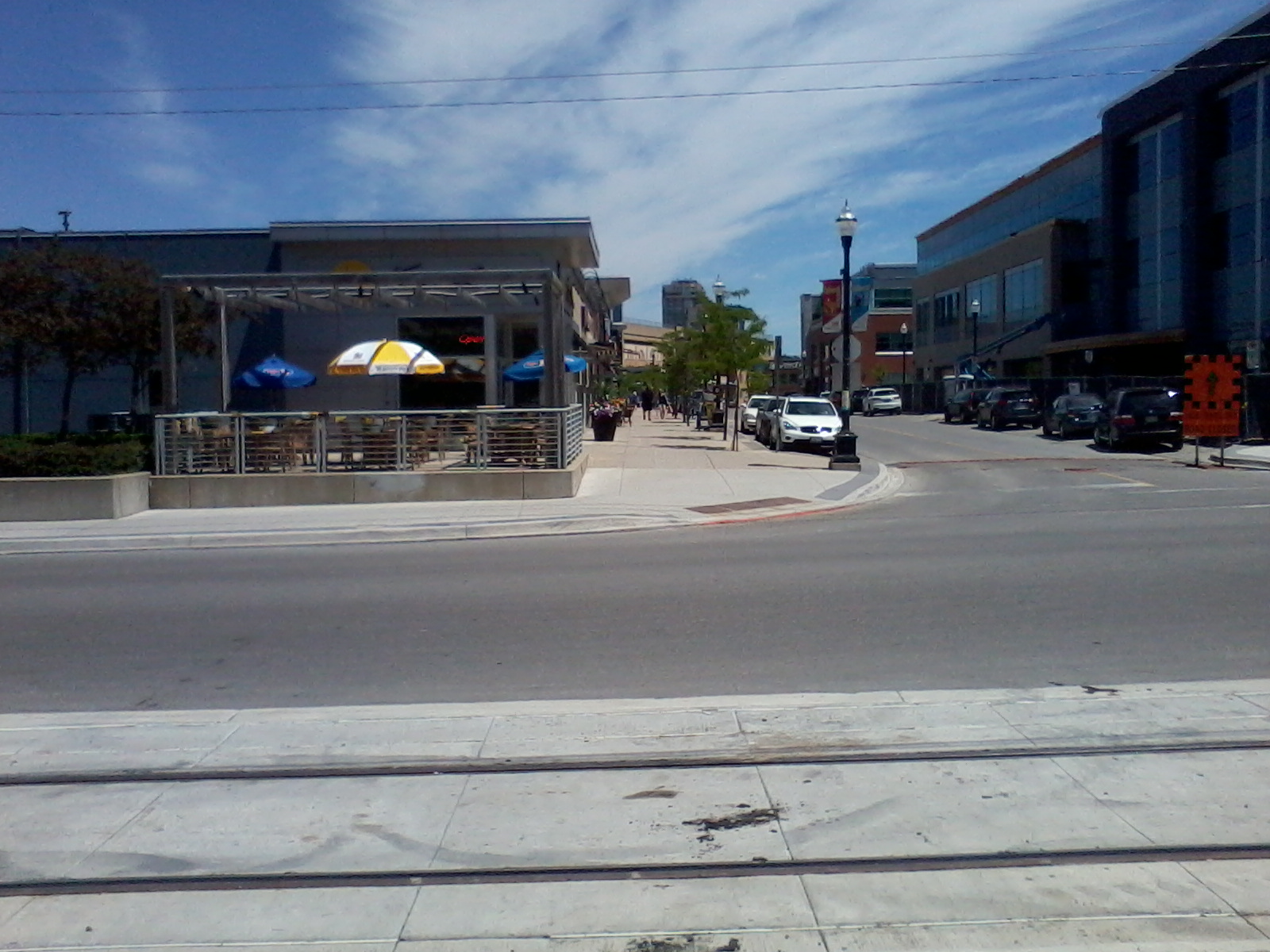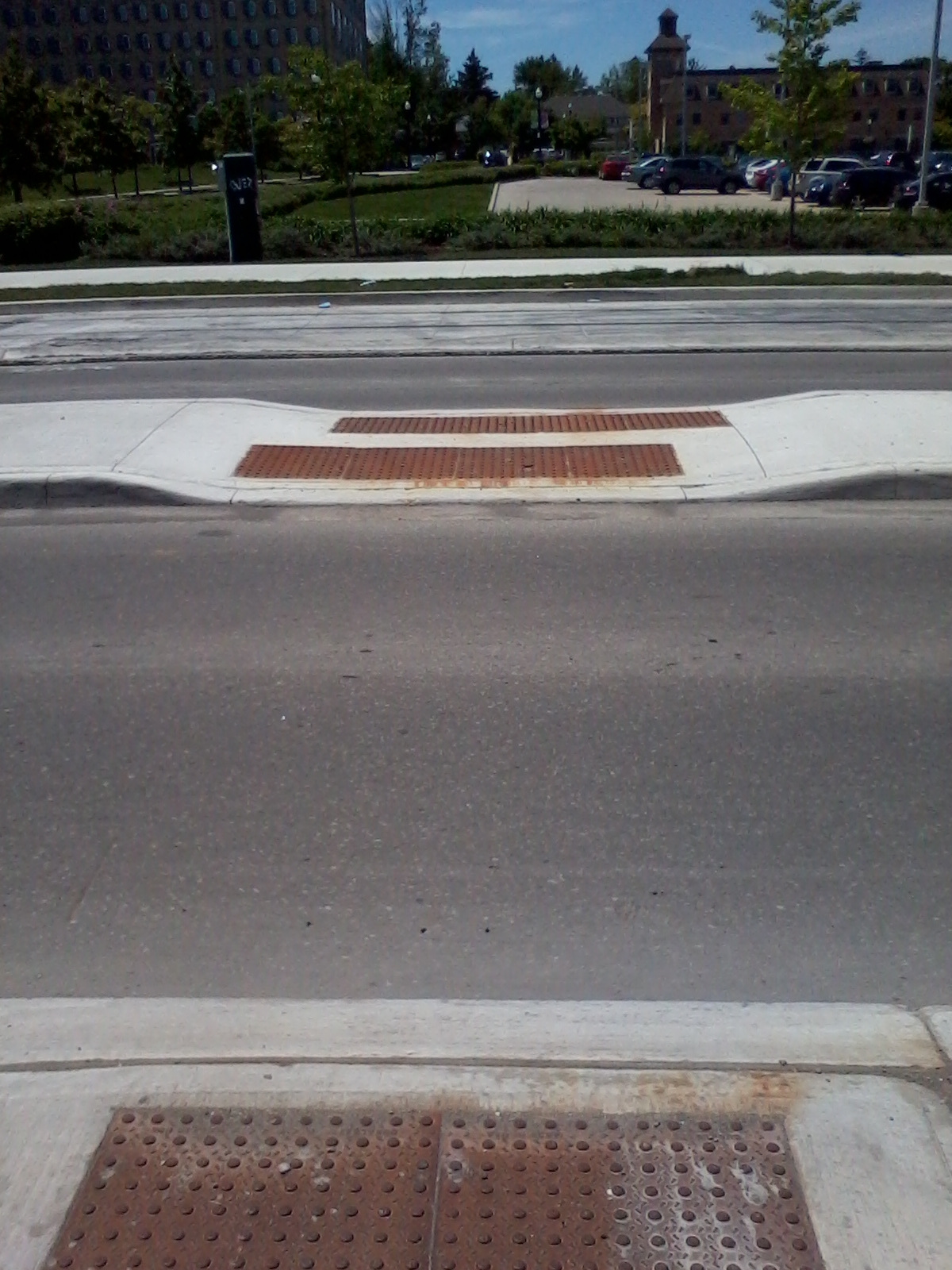Posts: 6,905
Threads: 32
Joined: Oct 2014
Reputation:
224
Heh, well played. 
What I learned in this project: Concrete is like drywall. It's okay to knock a hole in it or rip it down. You just put it back up when you're done, no biggie.
Posts: 2,015
Threads: 11
Joined: Oct 2014
Reputation:
77
This is the problem with the approach from the north end of the Willis platform.
If you are coming up south side of Willis there is a curb cut on the east side of Caroline, but not the west:

If you come up the north side of Willis there is a curb cut on the east side of Caroline, but not the west (it looks level but not seen is the standard curb height between the Ion track and the trail):

If you try and cross Caroline at the north or south side of Father David Bauer there is are sort of curb cuts on the west side of Caroline, but not the east (driveway):

Then a little further north on Caroline, north of the Father David Bauer intersection, there is this completely useless pedestrian island:

Everyone move to the back of the bus and we all get home faster.
Posts: 6,905
Threads: 32
Joined: Oct 2014
Reputation:
224
Until the final pavement goes down (any day now) we won't know what the design intent exactly is.
Posts: 2,015
Threads: 11
Joined: Oct 2014
Reputation:
77
I think given that the final pavement would already be done if not for some bad weather and that they have done re-work on concrete and curbs in this area already, the final design intent is clear.
The original plans seem to have proper connectivity:
http://rapidtransit.regionofwaterloo.ca/...df#page=23
Everyone move to the back of the bus and we all get home faster.
Posts: 6,905
Threads: 32
Joined: Oct 2014
Reputation:
224
I'm just saying, we are days away from seeing the final markings going in. I'd prefer to wait to see those before making judgment of the design.
...But I'm a designer.  so heavily biased haha
Posts: 2,163
Threads: 17
Joined: Sep 2014
Reputation:
76
I can't imagine any pavement markings that will make this make sense:
![[Image: attachment.php?aid=3796]](http://www.waterlooregionconnected.com/attachment.php?aid=3796)
Posts: 7,595
Threads: 36
Joined: Jun 2016
Reputation:
196
(06-09-2017, 09:10 AM)Markster Wrote: I can't imagine any pavement markings that will make this make sense:
![[Image: attachment.php?aid=3796]](http://www.waterlooregionconnected.com/attachment.php?aid=3796)
Clearly it is a pedestrian access to the LRT ROW.
I've been wondering about this for a while. It's not like one was built by one team years before and they just haven't gotten around to removing it....
Posts: 4,337
Threads: 1
Joined: May 2015
Reputation:
180
(06-09-2017, 09:10 AM)Markster Wrote: I can't imagine any pavement markings that will make this make sense:
![[Image: attachment.php?aid=3796]](http://www.waterlooregionconnected.com/attachment.php?aid=3796)
Agreed. There is no way this photo doesn’t represent a screw-up. Either there should be a path all the way across the road, or no curb cuts and textured edges. Which is correct is highly context-dependent, but it never makes sense to have unmatched curb cuts in all-new construction.
(If one side was new, with a cut, and the other old, with no cut (or vice-versa), it could make sense if there were a long-term plan to have a consistent plan)
The interesting questions are how this definite screw-up happened, and whether and how it will be fixed.
There is such a thing as giving too much deference to expertise, although I will admit that in our society at present the politically dominant error is completely ignoring expert opinion.
Posts: 7,595
Threads: 36
Joined: Jun 2016
Reputation:
196
06-09-2017, 09:37 AM
(This post was last modified: 06-09-2017, 09:38 AM by danbrotherston.)
(06-09-2017, 09:16 AM)ijmorlan Wrote: ....
There is such a thing as giving too much deference to expertise, although I will admit that in our society at present the politically dominant error is completely ignoring expert opinion.
Expertise has it's place, but when it comes to users, the user is always right. Contrary to what some companies might argue, you cannot hold a phone wrong, if the phone doesn't work how you hold it, then the phone is poorly designed. Just like, when you push on a door only to realize it was a pull door, the problem lies with the door ('s designer) not you.
https://www.youtube.com/watch?v=yY96hTb8WgI
This idea can be applied to our transportation design. If most of the traffic on the road is exceeding the speed limit, the road is designed poorly...etc etc etc.
Posts: 616
Threads: 4
Joined: Jul 2016
Reputation:
22
(06-09-2017, 09:10 AM)Markster Wrote: I can't imagine any pavement markings that will make this make sense:
![[Image: attachment.php?aid=3796]](http://www.waterlooregionconnected.com/attachment.php?aid=3796)
Can someone try to tweet or send this image to the ION/Region team? I've always noticed it too!
Posts: 4,404
Threads: 15
Joined: Aug 2014
Reputation:
124
There appears to be an easy fix: complete the crossing by cutting down the curb on the far side and building a short ramp to the sidewalk there. Not sure what would be required as far as 'watch for trains' signage.
Posts: 2,163
Threads: 17
Joined: Sep 2014
Reputation:
76
This discussion happens to have occurred just as I started making a list of all the oddities in the construction that just don't seem right.
I'm going to compile a list for a future TriTAG blog post.
If you notice any shortcomings, or defects, errors, or obvious fixes, it would be great if you could put them into this form:
ION Fix-It List
I know of a bunch of things that are problematic, but I also know I don't have a comprehensive list yet.
You can see the results (minus personal information) here:
https://docs.google.com/spreadsheets/d/1...ingle=true
Posts: 281
Threads: 0
Joined: Jul 2016
Reputation:
31
(06-09-2017, 09:37 AM)danbrotherston Wrote: Expertise has it's place, but when it comes to users, the user is always right. Contrary to what some companies might argue, you cannot hold a phone wrong, if the phone doesn't work how you hold it, then the phone is poorly designed. Just like, when you push on a door only to realize it was a pull door, the problem lies with the door ('s designer) not you.
https://www.youtube.com/watch?v=yY96hTb8WgI
This idea can be applied to our transportation design. If most of the traffic on the road is exceeding the speed limit, the road is designed poorly...etc etc etc.
I agree with this sometimes but not always. The door example is a favorite of mine, so I'm with you there. But:
"If most of the traffic on the road is exceeding the speed limit, the road is designed poorly...etc etc etc."
by the above logic we could just as easily say the speed limit is wrong because clearly the majority of users are fine going faster. The reality is that users are often ignorant/misguided/dumb/overconfident/etc. and the vast majority of them can be 'wrong' and the 'experts' right.
Posts: 7,595
Threads: 36
Joined: Jun 2016
Reputation:
196
06-09-2017, 11:02 AM
(This post was last modified: 06-09-2017, 11:02 AM by danbrotherston.)
(06-09-2017, 10:44 AM)SammyOES2 Wrote: (06-09-2017, 09:37 AM)danbrotherston Wrote: Expertise has it's place, but when it comes to users, the user is always right. Contrary to what some companies might argue, you cannot hold a phone wrong, if the phone doesn't work how you hold it, then the phone is poorly designed. Just like, when you push on a door only to realize it was a pull door, the problem lies with the door ('s designer) not you.
https://www.youtube.com/watch?v=yY96hTb8WgI
This idea can be applied to our transportation design. If most of the traffic on the road is exceeding the speed limit, the road is designed poorly...etc etc etc.
I agree with this sometimes but not always. The door example is a favorite of mine, so I'm with you there. But:
"If most of the traffic on the road is exceeding the speed limit, the road is designed poorly...etc etc etc."
by the above logic we could just as easily say the speed limit is wrong because clearly the majority of users are fine going faster. The reality is that users are often ignorant/misguided/dumb/overconfident/etc. and the vast majority of them can be 'wrong' and the 'experts' right.
I would argue the speed limit is part of the design of the road, so that is a valid interpretation. But if we raise the speed limit, our problems instead become "the road is too dangerous because speeds are too high".
And absolutely, users are all of those things. The point is, the design must accommodate those things.
I was mainly trying to point out that we cannot blame users for using something wrong, if they use it wrong, it's because designers failed to design it so it's use is obvious and intuitive.
I think what you're referring to when you say the vast majority are wrong and experts are right isn't about using, it's about designing. People tend to think they know better than designers, which ironically, may very well lead to the bad designs which causes them to act wrong anyway. Like people often think designing something for higher speeds makes it safer. Many things about design are counterintuitive.
Posts: 6,905
Threads: 32
Joined: Oct 2014
Reputation:
224
HDR Friday!
<blockquote class="twitter-tweet" data-lang="en"><p lang="en" dir="ltr">Sunrise at Kitchener Market. <a href="https://twitter.com/hashtag/wrLRT?src=hash">#wrLRT</a> <a href="https://twitter.com/hashtag/wrawesome?src=hash">#wrawesome</a> <a href="https://t.co/0vB4OpFI4j">pic.twitter.com/0vB4OpFI4j</a></p>— iain (@Canardiain) <a href="https://twitter.com/Canardiain/status/873119560668295168">June 9, 2017</a></blockquote>
|





